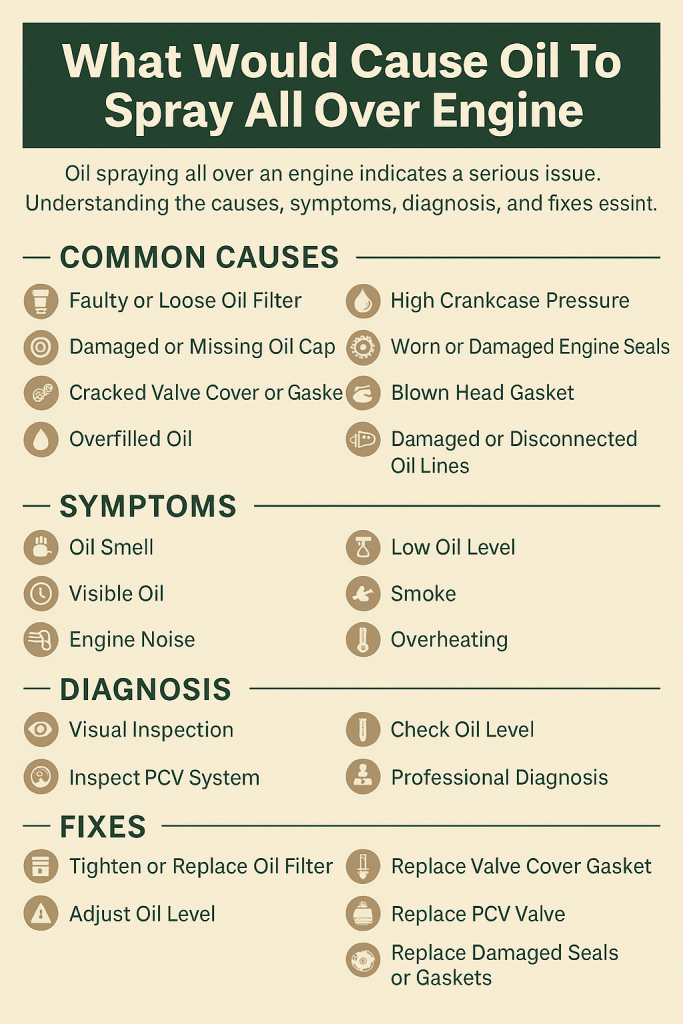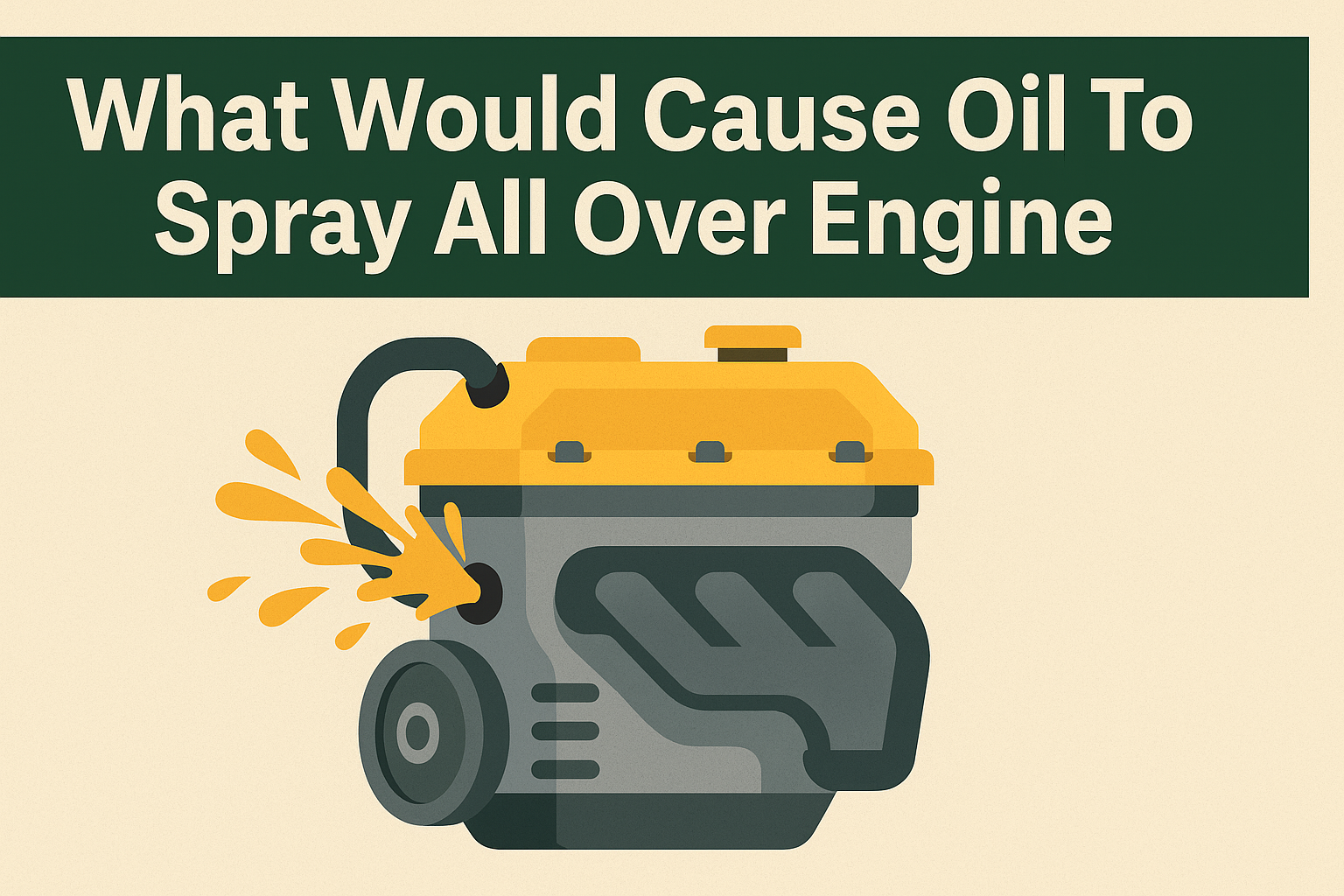Oil spraying all over an engine is not just messy—it’s a red flag that something is seriously wrong. Whether you’re a DIY mechanic, a car enthusiast, or just someone trying to understand vehicle maintenance, this comprehensive guide will help you pinpoint the causes and take action. Let’s dive deep into what might cause oil to spray all over your engine.
Introduction: The Heartbeat of Your Engine
Your car’s engine relies on clean, well-contained oil to function efficiently. When oil starts spraying out and coating your engine bay, it’s not just a nuisance—it can cause severe damage and lead to costly repairs. Understanding the root causes of this issue is crucial for vehicle health and your peace of mind.
Section 1: Understanding How Oil Works in an Engine
Before we dive into potential problems, let’s quickly review how oil operates in your engine:
- Lubrication: Oil lubricates moving parts, reducing friction and preventing wear.
- Cooling: It helps dissipate heat from high-friction areas.
- Cleaning: Oil traps dirt, debris, and carbon, which are then removed via oil filters.
- Sealing: Oil seals gaps between pistons, rings, and cylinder walls to maintain compression.
When oil is leaking or spraying, these functions are compromised, leading to overheating, increased friction, and potential engine failure.
Section 2: Common Causes of Oil Spraying Over the Engine
1. Faulty or Loose Oil Filter
An improperly installed, damaged, or clogged oil filter can cause oil to leak under pressure. If the filter is loose or its seal is compromised, oil will spray outward, especially when the engine is running at higher RPMs.
2. Damaged or Missing Oil Cap
The oil filler cap seals the engine’s oil system. If it’s damaged, missing, or loose, pressure can build up inside the crankcase, forcing oil to escape through the opening. This can result in oil splattering the engine bay and underside of the hood.
3. Cracked Valve Cover or Gasket
The valve cover and its gasket seal the top of the engine, preventing oil from leaking out. If the cover is cracked or the gasket is worn, oil can seep or spray out, especially under high pressure. Valve cover gasket leaks are common in older engines or those with high mileage.
4. Overfilled Oil
Too much oil in the crankcase can increase pressure, forcing oil past seals and gaskets. This can lead to oil spraying out from weak points in the system, such as the oil cap, dipstick tube, or gaskets.
5. High Crankcase Pressure
Crankcase pressure builds naturally as combustion gases leak past the piston rings. Normally, the Positive Crankcase Ventilation (PCV) system manages this pressure. If the PCV valve or system becomes clogged or fails, pressure builds up, forcing oil out through gaskets, seals, and openings.
6. Worn or Damaged Engine Seals
The engine relies on several seals, including:
- Front and rear main seals
- Camshaft seals
- Crankshaft seals
If these seals wear out or crack, oil can leak under pressure and spray onto engine components.
7. Blown Head Gasket
A head gasket failure can allow coolant and oil to mix and increase crankcase pressure. This can lead to oil blowing out from multiple places, including vents, gaskets, and seals.
8. Damaged or Disconnected Oil Lines
Turbocharged engines or engines with external oil coolers use oil lines to circulate oil. If these lines crack, loosen, or disconnect, pressurized oil will spray everywhere, potentially causing severe engine damage.
9. Engine Damage or Cracks
In rare cases, cracks in the engine block, cylinder head, or oil pan can cause oil to spray. This is often the result of severe overheating, accidents, or manufacturing defects.
Section 3: Symptoms to Watch For
If you suspect an oil spray issue, watch for:
- Oil smell: A strong, burnt-oil odor while driving or after stopping.
- Visible oil: Puddles or splatter on engine components, under the hood, or on the ground.
- Low oil level: Frequent oil top-ups or oil warning lights.
- Smoke: Blue or white smoke from the exhaust can indicate oil burning.
- Engine noise: Increased ticking, knocking, or rattling due to low oil pressure.
- Overheating: A sudden rise in engine temperature due to lack of lubrication.
Section 4: How to Diagnose the Source
- Visual Inspection:
- Look for fresh oil on the valve cover, oil cap, or oil filter area.
- Inspect oil lines for damage or disconnections.
- Check around seals and gaskets for wet spots or drips.
- Check Oil Level:
- If low, it’s a sign of a leak. But don’t just top it off—find the source.
- Inspect PCV System:
- Remove the PCV valve and shake it; it should rattle. If clogged, replace it.
- Check Oil Pressure:
- Use a gauge to measure oil pressure. Low pressure could indicate internal leaks or pump failure.
- Professional Diagnosis:
- If you can’t find the source, take the car to a mechanic. They can perform a pressure test or use UV dye to trace leaks.

Section 5: How to Fix It
Here’s a breakdown of potential fixes:
- Tighten or Replace Oil Filter: Make sure it’s installed correctly and the gasket is intact.
- Replace Oil Cap: Get a new cap if the old one is damaged or missing.
- Replace Valve Cover Gasket: This is a common DIY fix with basic tools.
- Adjust Oil Level: Drain excess oil if overfilled.
- Replace PCV Valve: Inexpensive and usually easy to access.
- Replace Damaged Seals or Gaskets: Requires more time and skill but necessary for long-term fixes.
- Repair or Replace Oil Lines: Especially important in turbocharged engines.
- Professional Engine Repair: For major damage or cracked components, professional help is essential.
Section 6: Preventing Oil Spray Issues
Prevention is key. Here’s how to avoid oil spray problems:
- Regular Oil Changes: Use high-quality oil and replace filters on schedule.
- Inspect Seals and Gaskets: During routine maintenance, look for wear or damage.
- Check PCV System: Keep it clean and replace parts as needed.
- Don’t Overfill Oil: Always measure accurately when adding oil.
- Use Correct Torque: When installing components like the oil filter or valve cover, use the correct torque specs.
- Watch for Warning Signs: Address leaks, smells, or engine noises promptly.
Conclusion: Take Action Before It’s Too Late
If you notice oil spraying over your engine, don’t ignore it. A small leak can quickly escalate into a costly repair or engine failure. By understanding the common causes—such as faulty filters, worn gaskets, high crankcase pressure, or damaged seals—you can take action to fix the issue.
Whether you choose to DIY or consult a professional mechanic, addressing the root cause early will save you time, money, and headaches. Stay proactive with maintenance, and your engine will thank you with reliable performance for miles to come.

